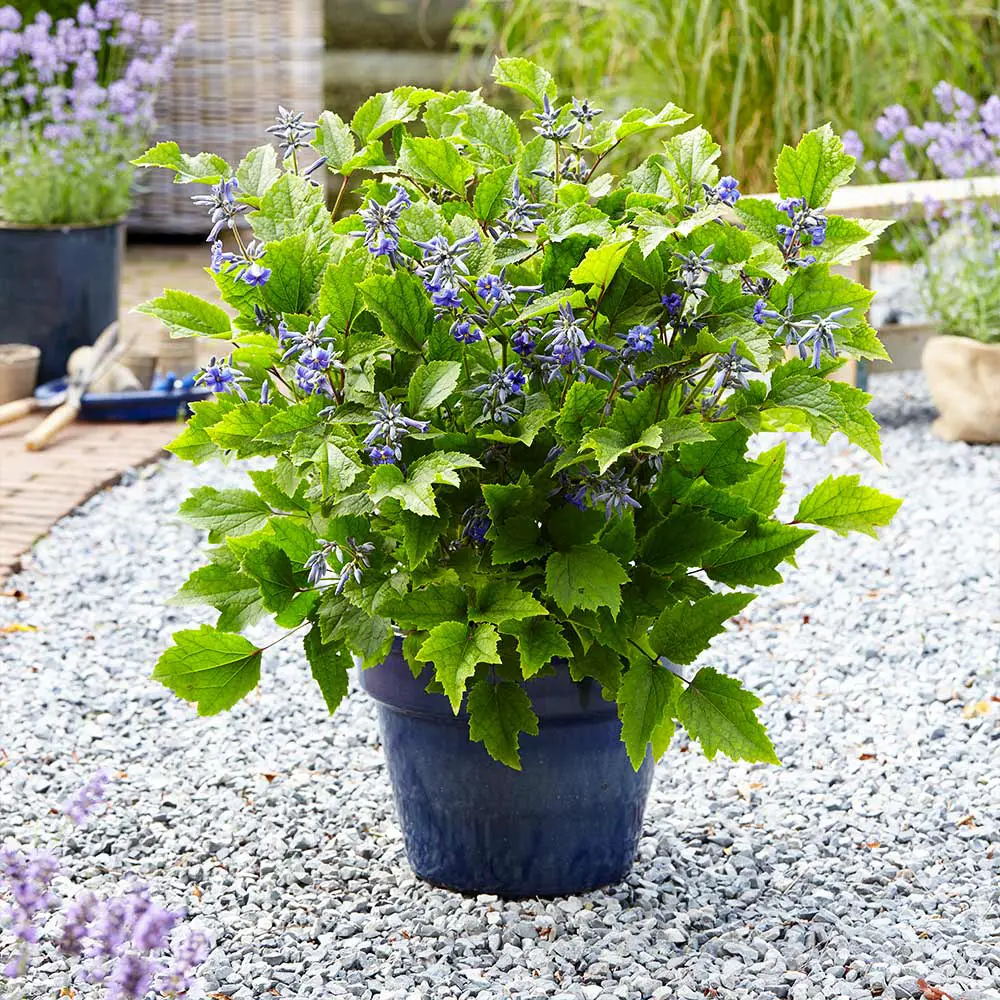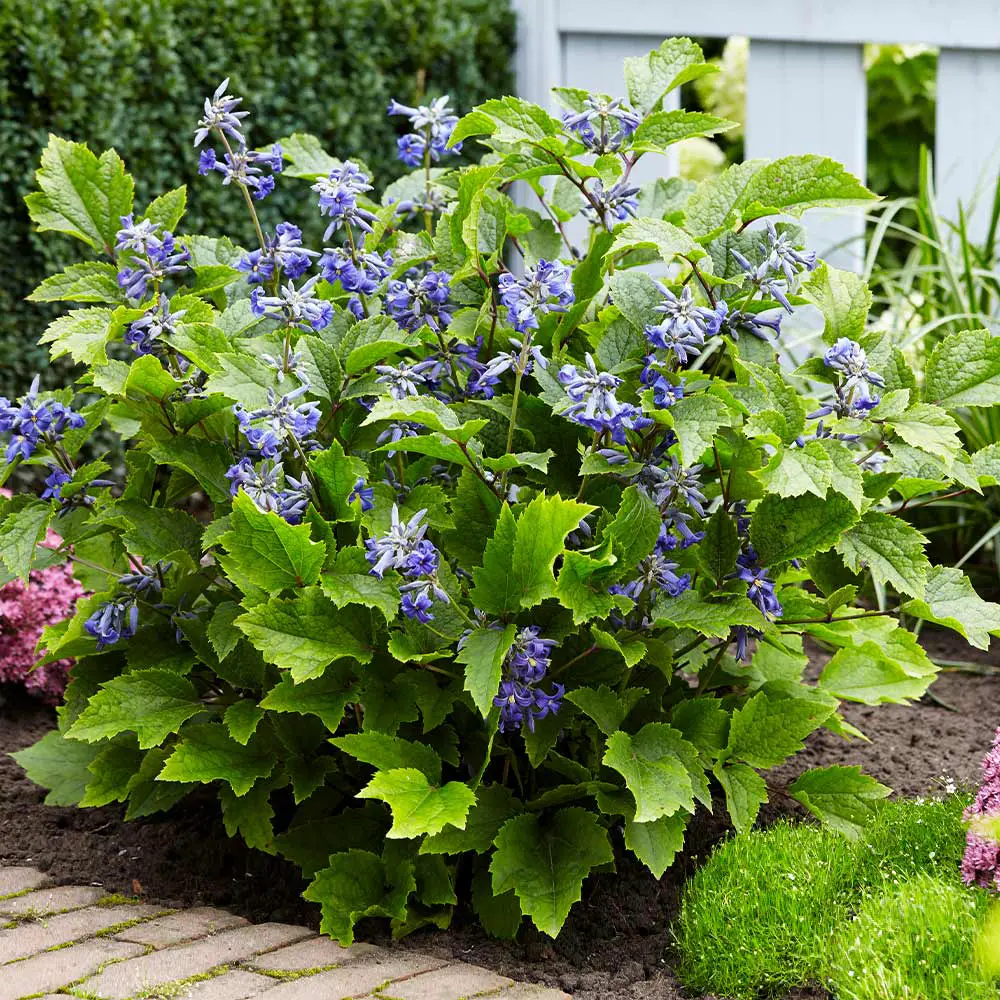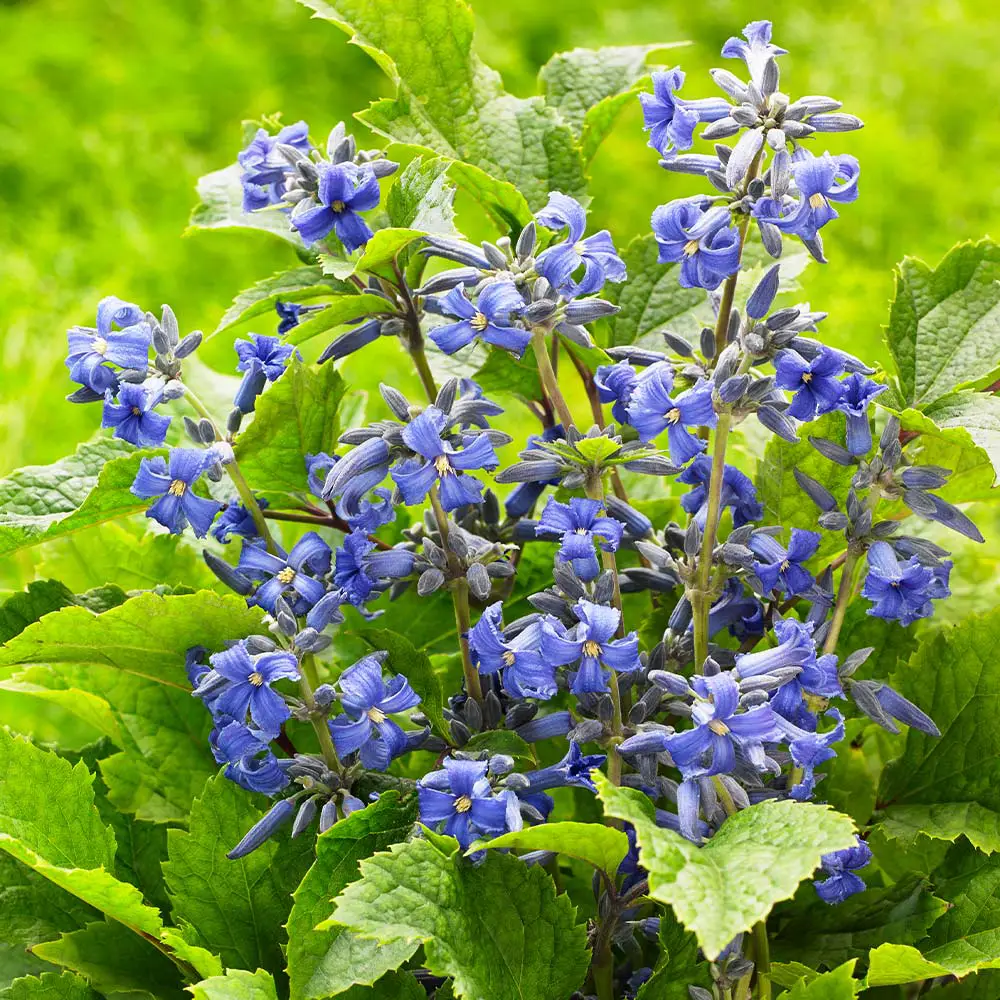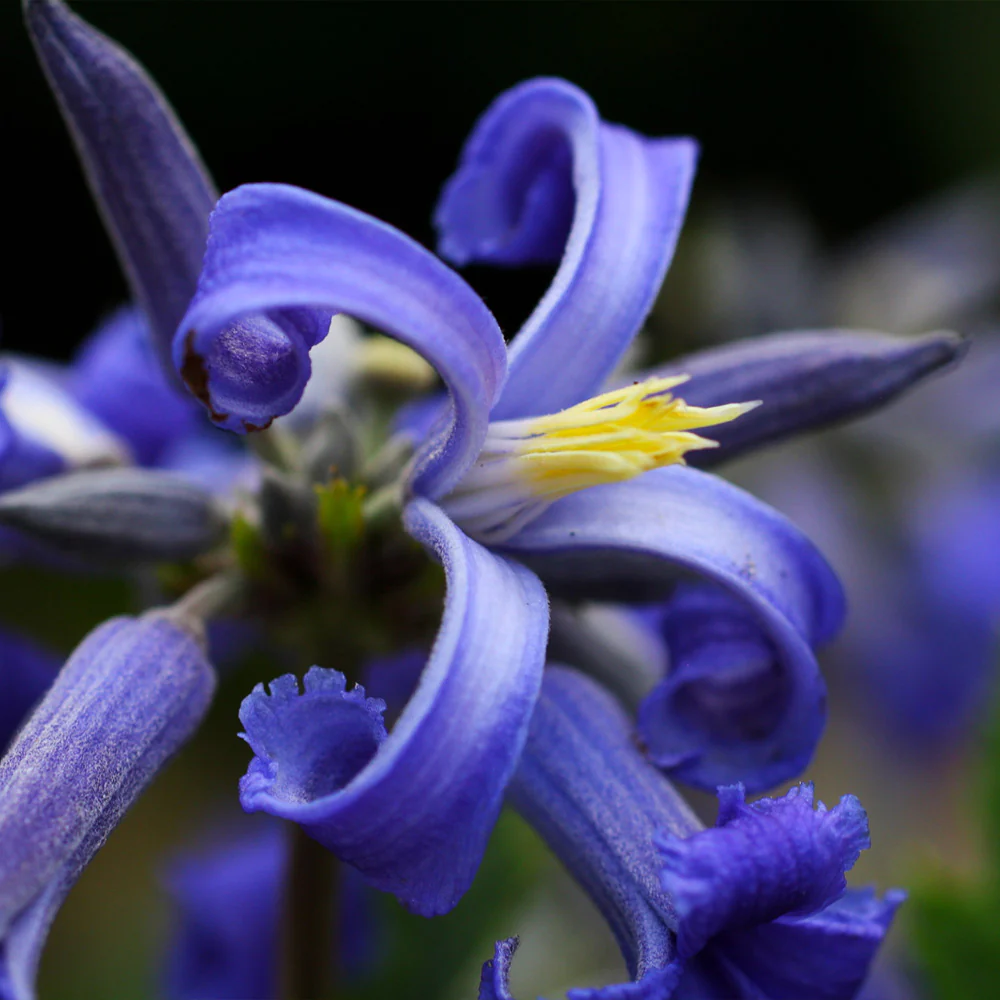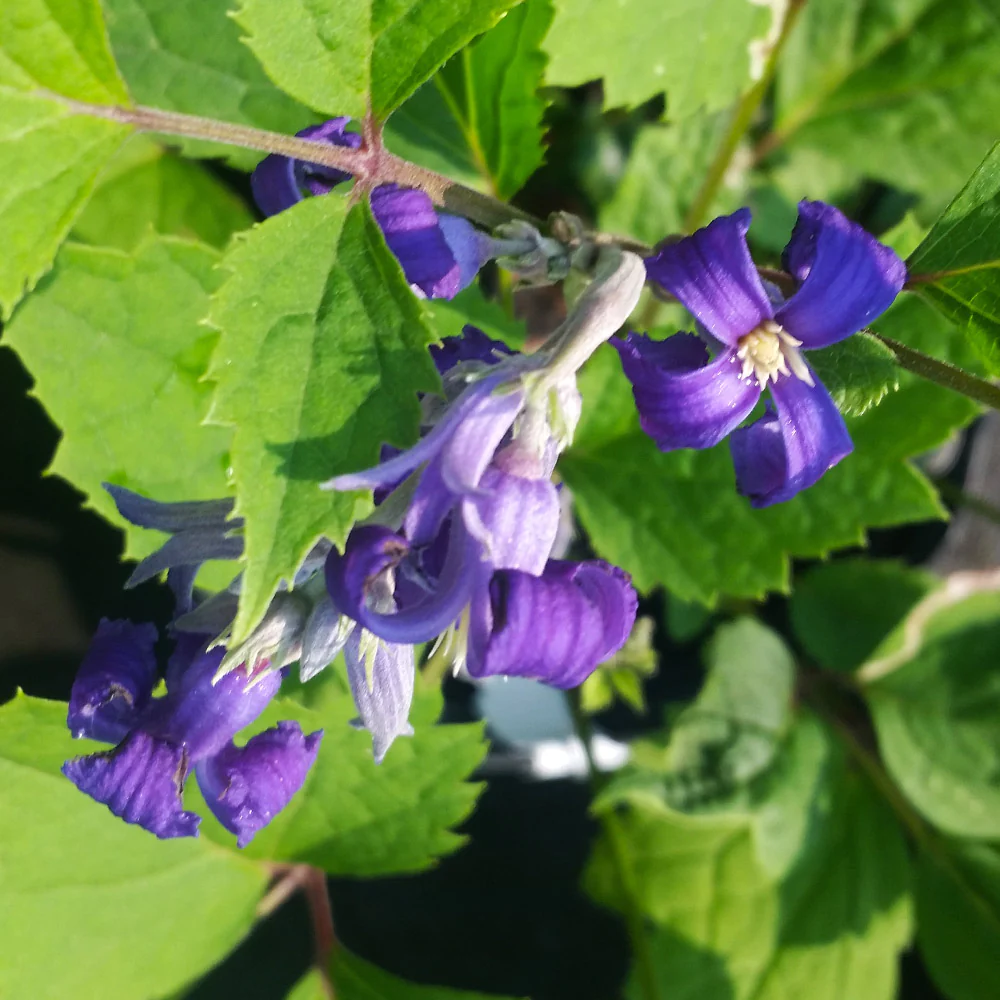This post contains affiliate links. If you buy something from one of our links we may earn a commission. Thanks
Ready to add a pop of color to your indoor space? Discover the joys of growing clematis indoors in pots with our simple guide!
To grow Clematis indoors in pots, choose a well-draining pot and a sunny location near a window. Use a high-quality potting mix and provide a trellis for support. Keep the soil evenly moist but not waterlogged. Fertilize every 4-6 weeks during the growing season and prune as needed to maintain shape.
Brighten up your home today with these beautiful flowers.
Are you looking for a way to bring some color and life into your indoor space? Growing clematis indoors in pots might just be the perfect solution for you!
Clematis are beautiful flowering plants that are easy to care for and can add a touch of elegance to any room.
Plus, with our simple guide, you’ll be able to successfully grow clematis in pots and enjoy their stunning blooms all year round!
An Introduction To Growing Clematis Indoors In Pots
Are you ready to add some greenery to your indoor space? Look no further than clematis!
This beautiful flowering plant is easy to grow indoors in pots, and it’s sure to brighten up any room with its vibrant blooms.
In this article, we’ll give you all the tips and tricks you need to successfully grow clematis indoors, so you can enjoy the beauty of this plant year-round. Let’s get started!
What is Clematis?
Clematis is a beautiful and versatile flowering plant that belongs to the buttercup family.
It’s known for its showy and colorful blooms that come in a range of shapes and sizes.
Clematis can grow as vines or shrubs and are commonly found in gardens, but they can also be grown indoors in pots.
Benefits of Growing Clematis Indoors in Pots
There are many benefits to growing clematis indoors in pots.
First and foremost, clematis adds a pop of color to any indoor space, making it an excellent way to brighten up your home decor.
Additionally, clematis is easy to care for, and growing it in pots allows you to control its environment, which means you can enjoy its blooms year-round.
Finally, growing clematis in pots is a great option if you have limited outdoor space or if you live in an apartment or condo.
What’s In The Article Growing Clematis Indoors In Pots?
• In this article, we’ll walk you through all the steps you need to successfully grow clematis indoors in pots.
• We’ll cover everything from choosing the right pot and soil to pruning and training your plant.
• We’ll also discuss the importance of providing your clematis with the right lighting, temperature, and humidity.
• Additionally, we’ll touch on the need for a trellis and offer some troubleshooting tips to help you keep your clematis healthy and happy.
• By the end of this article, you’ll be well on your way to growing beautiful clematis indoors in pots!
Are some varieties better for indoors?
There are some clematis varieties that are better suited for growing indoors in pots than others.
Generally, smaller and more compact varieties of clematis are better suited for growing in pots indoors, as they require less space to grow and can be easily trained to climb a trellis or other support.
Here are a few clematis varieties that are well-suited for indoor growing:
Introducing the Self-Supporting Clematis: New Love
If you’re looking for a plant that’s both easy to care for and stunning to look at, the self-supporting Clematis called New Love is a perfect choice. This perennial shrub boasts gorgeous blue-purple blooms that set it apart from other plants in your garden.
What makes this Clematis truly unique is its ability to form a bushy, upright silhouette that doesn’t require any additional support structures.
Its star-shaped indigo flowers bloom into a delicate, curled shape from late spring to early fall, adding a touch of elegance to any garden.
But it’s not just humans who are drawn to this beauty. The sweet fragrance of the Self-Supporting Clematis attracts hummingbirds and bees, making it a welcome addition to any wildlife-friendly garden.
What’s more, this particular variety of Clematis flowers on new wood, so you won’t have to worry about trimming it back like other varieties. You can enjoy its big, blue-scented flowers without any added hassle.
Overall, the Self-Supporting Clematis is an excellent choice for any gardener looking for a low-maintenance, visually striking plant that also attracts wildlife. This is the perfect variety to grow indoors and since it’s hardy to -30° it is perfect for growing outdoors too.
| Mature Height: | 2-3 ft. |
| Mature Width: | 1-2 ft. |
| Sunlight: | Full-Partial |
| Growth Rate: | Moderate |
| Botanical Name: | Clematis heracleifolia |
| Grows Well In Zones: | 3-9 outdoors |

Growing Zones: 3-9 outdoors
(hardy down to -30℉)
You can buy your New Love Clematis here
Choosing the Right Pot
When it comes to growing clematis indoors in pots, choosing the right pot is crucial to the success of your plant.
You’ll want to choose a pot that is the right size for your clematis and that provides good drainage.
Additionally, the material and style of the pot can also impact the health and growth of your plant.
In this section, we’ll walk you through the key factors to consider when selecting a pot for your clematis.
Considerations for Pot Size
When selecting a pot for your clematis, size matters.
You’ll want to choose a pot that is large enough to accommodate the root system of your plant, but not so large that it overwhelms your indoor space.
A general rule of thumb is to choose a pot that is at least 12 inches in diameter and 12 inches deep.
If you’re growing a larger variety of clematis, you may need to opt for a larger pot.
Additionally, be sure to consider the size of your clematis at maturity, as you don’t want to have to repot your plant too frequently.
Types of Pots
When it comes to selecting a pot for your clematis, there are several options to choose from.
Clay pots are a popular choice, as they provide good drainage and are heavy enough to support climbing clematis.
However, they can be prone to cracking and can dry out quickly.
Plastic pots are a more lightweight and affordable option, and they also provide good drainage.
Fabric pots are another option that is gaining popularity, as they promote healthy root growth and are easy to store when not in use.
Drainage Considerations
Good drainage is essential for the health and growth of your clematis.
When selecting a pot, be sure to choose one that has drainage holes in the bottom.
Additionally, you may want to consider adding a layer of gravel or rocks to the bottom of your pot to improve drainage.
It’s also important to avoid overwatering your clematis, as too much water can lead to root rot and other issues.
Be sure to allow the soil to dry out slightly between waterings, and always empty any excess water from the saucer underneath your pot.
Choosing the Right Soil
Choosing the right soil is another important factor to consider when growing clematis indoors in pots.
The soil you choose will impact the growth and health of your plant, so it’s important to choose a soil that provides the right balance of nutrients, drainage, and moisture retention.
In this section, we’ll walk you through the key factors to consider when selecting soil for your indoor clematis.
Importance of Soil Selection
Choosing the right soil for your clematis is critical to its overall health and growth.
The soil provides essential nutrients, moisture, and support for your plant’s root system.
When growing clematis indoors in pots, it’s especially important to choose soil that promotes healthy root growth and provides good drainage.
Recommended Soil Mix for Clematis: Coco Coir and Perlite vs. Peat Mixes
When it comes to selecting soil for your indoor clematis, there are a few options to choose from.
Coco coir and perlite mixes are becoming increasingly popular for their ability to provide good drainage and aeration for your plant’s root system.
Additionally, they are a more sustainable option than traditional peat mixes.
Peat mixes are also a common choice, but they can become compacted over time, leading to poor drainage and root growth.
Other Soil Considerations
In addition to selecting the right soil mix, there are a few other soil considerations to keep in mind when growing clematis indoors in pots.
First, be sure to choose soil that is free of pests and diseases, as these can quickly spread to your plant and cause damage.
Don’t use garden soil for this reason and it will also compact heavily in a pot.
Additionally, you may want to consider adding a slow-release fertilizer to your soil mix to provide your plant with essential nutrients.
Be sure to follow the instructions on the fertilizer package carefully to avoid overfertilizing your clematis.
Finally, it’s a good idea to refresh your soil every few years to ensure that it remains healthy and nutrient-rich for your plant.
Planting Clematis
Once you’ve selected the right pot and soil for your indoor clematis, it’s time to move on to planting.
Proper planting is key to ensuring that your clematis grows and thrives indoors.
In this section, we’ll walk you through the key steps to follow when planting your clematis in a pot, from preparing the pot to placing the plant in the soil. Let’s get started!
Preparing the Pot for Planting
Before planting your clematis, you’ll need to prepare the pot to ensure that it provides the right environment for your plant to thrive.
First, make sure your pot has adequate drainage holes to allow excess water to drain away from the roots.
You may also want to add a layer of gravel or rocks to the bottom of the pot to improve drainage. Finally, partially fill the pot about 1/3 full with your chosen soil mix, leaving enough space at the top for your plant.
Planting Clematis in the Pot
When it’s time to plant your clematis, start by gently removing it from its nursery container.
Carefully loosen any tangled roots, being careful not to damage them.
Place the plant in the center of the pot, making sure that the top of the root ball is level with the soil surface.
Fill in any gaps with additional soil, pressing it down gently around the roots.
Water the soil thoroughly to settle it around the roots to eliminate any air pockets.
Watering and Fertilizing Considerations
Once your clematis is planted, it’s important to take care of it properly.
This includes regular watering and fertilizing to ensure that your plant gets the nutrients it needs to grow and thrive.
You may want to consider adding slow-release fertilizer spikes to your potting soil to provide your clematis with a steady supply of nutrients over time.
Additionally, fertilizer spikes can be a convenient way to add nutrients directly to the soil around your plant.
When it comes to watering, be sure to keep the soil moist but not waterlogged, as excessive moisture can lead to root rot.
Water your clematis when the top inch of soil feels dry to the touch.
Growing Clematis Indoors
Now that you’ve planted your clematis in the right pot with the right soil, it’s time to start growing!
Growing clematis indoors can be a fun and rewarding experience, but it’s important to know how to care for your plant properly to ensure its health and growth.
In this section, we’ll cover the key factors to consider when growing clematis indoors, from lighting and temperature to pruning and support. Let’s dive in!
Lighting Considerations
Light is an important factor in the growth and development of your clematis plant.
While clematis prefers full sun when grown outdoors, indoor plants may not receive enough natural light to thrive.
To ensure that your clematis gets enough light, place it near a bright window that receives several hours of direct sunlight each day.
If you don’t have a window that gets enough sunlight, consider using artificial grow lights to supplement natural light.
Temperature Considerations
Clematis is a cold-hardy plant that can tolerate low temperatures, but indoor plants may require slightly warmer temperatures than outdoor plants.
Ideal temperatures for growing clematis indoors range from 60 to 75 degrees Fahrenheit.
Avoid placing your plant near cold drafts or heating vents, as this can cause fluctuations in temperature that can stress the plant.
Humidity Considerations
Clematis prefers moderate to high humidity, which can be a challenge to maintain indoors.
You can increase humidity around your plant by placing a tray of water near the pot, using a humidifier, or misting the plant with water regularly.
Be careful not to let water sit on the leaves or flowers for too long, as this can lead to fungal infections or other issues.
Pruning and Training Clematis
Pruning and training are essential parts of growing clematis, whether you’re growing them indoors or outdoors.
Proper pruning and training can help to promote healthy growth and ensure that your plant looks its best.
In this section, we’ll cover the basics of pruning and training clematis, including when to prune, how to train your plant to climb, and tips for shaping your plant to your liking.
Importance of Pruning
Pruning is an important aspect of clematis care, as it promotes healthy growth and can help your plant to produce more flowers.
Pruning also helps to keep your plant in check and prevent it from becoming too leggy or sprawling.
Techniques for Pruning Clematis
The specific pruning technique you use will depend on the type of clematis you’re growing, as well as the growth habit of the plant.
In general, clematis can be divided into three groups based on their pruning needs:
Group 1 (early flowering), Group 2 (large flowering), and Group 3 (late flowering).
Each group requires slightly different pruning techniques, so it’s important to know which group your plant belongs to before you start pruning.
Training Clematis to Climb
Clematis is a climbing plant that will naturally want to climb up anything it can find.
But it’s important to provide your plant with proper support and guidance to ensure that it climbs where you want it to.
You can use a trellis, wire supports, or other climbing aids to train your clematis to climb in the direction you want.
As your plant grows, you may need to adjust the support to accommodate its new growth.
The Need for a Trellis
When it comes to growing clematis, a trellis is essential for ensuring that your plant grows up and not out.
Clematis is a climbing plant that will naturally want to climb up anything it can find, but without proper support, it can become unruly and tangled.
In this section, we’ll talk about the importance of a trellis for growing clematis, as well as some tips for choosing and installing the right trellis for your plant.
Explanation of why clematis needs a trellis:
As mentioned earlier, clematis is a climbing plant that needs support to grow upwards.
Without a trellis, it can quickly become tangled and unruly, making it difficult to care for and maintain.
A trellis also helps to prevent the plant from leaning too far to one side, which can cause it to become unbalanced and fall over.
Types of trellises:
There are many different types of trellises available, and the best one for your clematis will depend on the size of your pot and the type of clematis you’re growing.
Some common types of trellises include bamboo stakes, wire mesh, and wooden trellises.
How to install a trellis in a pot:
Once you’ve chosen the right trellis for your clematis, it’s time to install it in the pot.
First, make sure the trellis is the appropriate size for your pot and that it’s sturdy enough to support the weight of your plant.
Next, insert the trellis into the soil, making sure it’s firmly anchored.
You may also want to secure the trellis to the pot using wire or string to prevent it from tipping over.
Finally, train your clematis to climb the trellis by gently wrapping its stems around the support.
With a little patience and care, your clematis will grow beautifully up the trellis and add a stunning touch to your indoor space.
Troubleshooting Clematis
Growing clematis indoors can be a rewarding experience, but like any plant, it may encounter some challenges along the way.
In this section, we will discuss common issues that may arise when growing clematis indoors in pots and offer some tips on how to troubleshoot them.
Whether it’s yellowing leaves or wilting stems, we’ve got you covered. Let’s dive in and learn how to keep your clematis healthy and thriving.
Clematis Problems
It’s not uncommon for clematis to face issues such as yellowing leaves, wilting stems, or stunted growth.
In this section, we will cover some common issues that you may encounter and offer some solutions to address them.
Whether it’s overwatering, underwatering, or inadequate lighting, we’ll help you diagnose the issue and offer tips on how to get your clematis back on track.
Pests And Diseases
Just like any plant, clematis is susceptible to pests such as aphids, spider mites, and scale insects.
In this section, we will discuss some common pests that may attack your clematis and offer some tips on how to control them.
Whether it’s using insecticidal soap, neem oil or introducing natural predators, we’ll help you keep your clematis pest-free.
In addition to pests, clematis can also be prone to diseases such as powdery mildew, leaf spot, and wilt.
In this section, we will discuss some ways to prevent and manage these diseases. From practicing good sanitation to using fungicides, we’ll help you keep your clematis healthy and disease-free.
Keeping An Eye Out For Pests
When growing clematis indoors in pots, it’s important to keep an eye out for common pests that can affect the health of your plant.
Some of the most common pests include aphids, spider mites, and mealybugs.
If you notice any of these pests on your clematis, there are several control methods you can try.
One effective method is to simply spray the plant with a solution of water and dish soap.
Another option is to use neem oil, which is a natural insecticide.
You can also purchase commercial insecticides, but be sure to choose one that is safe for indoor use and follow the instructions carefully.
In addition to pest control, it’s also important to practice good hygiene when growing clematis indoors.
This means keeping the pot and surrounding area clean and free of debris, as this can attract pests and disease.
Finally, consider placing a sticky trap near your clematis to catch any flying insects that may be in the area.
With proper care and attention, you can keep your indoor clematis pest-free and thriving.
What Are The Signs Of Insect Pests
Here are some signs to look out for when identifying common insect pests that can affect clematis plants:
Aphids: These are small, pear-shaped insects that can be green, brown, or black in color.
They can often be found on the undersides of leaves, along the stems, and on buds and flowers.
Signs of an aphid infestation include curled or distorted leaves, sticky honeydew on leaves, and the presence of ants.
Spider mites: These are tiny, reddish-brown insects that can be found on the undersides of leaves.
Signs of spider mite infestation include stippling or discoloration on leaves, fine webbing between leaves and stems, and a dusty appearance on the plant.
Whiteflies: These are small, white insects that can be found on the undersides of leaves.
Signs of whitefly infestation include yellowing leaves, sticky honeydew on leaves, and the presence of whitefly adults and larvae.
Mealybugs: These are soft-bodied insects that can be found on the undersides of leaves and on the stems.
Signs of mealybug infestation include a white, cottony substance on leaves, stunted growth, and leaf drop.
It’s important to regularly inspect your clematis plant for these signs of pest infestation so you can take action quickly to prevent further damage.
Common control methods for insect pests
Aphids:
You can try to remove them physically by spraying a strong stream of water on the plant or by wiping the leaves with a damp cloth.
Another option is to use insecticidal soap or neem oil, which can be sprayed on the affected areas of the plant.
Encouraging natural predators like ladybugs and lacewings can also help control aphids.
Spider mites:
Similar to aphids, you can try to remove spider mites by spraying the plant with a strong stream of water or wiping the leaves with a damp cloth.
Insecticidal soap or neem oil can also be effective. If the infestation is severe, you may need to use a miticide.
Whiteflies:
Yellow sticky traps can be used to capture adult whiteflies, and insecticidal soap or neem oil can be sprayed on the affected areas.
Encouraging natural predators like parasitic wasps and ladybugs can also help control whiteflies.
Mealybugs:
Physically removing them by wiping the leaves with a damp cloth or a cotton swab dipped in rubbing alcohol can be effective for small infestations.
Insecticidal soap or neem oil can also be used. For severe infestations, you may need to use a systemic insecticide.
In general, it’s important to monitor your clematis plant regularly for signs of pest infestation and to take action quickly to prevent further damage.
FAQs Clematis Indoors in Pots
Growing clematis in pots brings the beauty of this flowering vine to small spaces and indoor settings, but it also presents unique challenges.
One of the key considerations for potted clematis is seasonal care, including how to manage the plant in winter.
Let’s delve into some frequently asked questions that will guide you through the specific needs of potted clematis, from winter care to pruning and repotting.
Q: What to do with potted clematis in winter?
A: During winter, reduce watering and move the pot to a cool, but frost-free area if you can. Some people choose to insulate the pot to protect the roots from freezing temperatures.
Q: When should I repot my clematis?
A: The best time to repot clematis is in late winter or early spring, just before the plant starts active growth. Choose a pot that is 2-3 inches larger in diameter than the current one.
Q: How do you prune a potted clematis?
A: The pruning needs depend on the clematis variety. Generally, prune to remove dead or weak stems in late winter or early spring, and shape the plant as desired. Always check the specific needs of your variety.
Q: Will clematis survive in pots?
A: Yes, clematis can thrive in pots if provided with adequate drainage, appropriate soil, and sufficient sunlight. However, extra care is needed to protect it from extreme temperatures.
Q: What happens if you don’t prune clematis?
A: Lack of pruning can result in a tangled mass of stems with reduced airflow and fewer flowers.
It can also make the plant more susceptible to disease. It’s advisable to prune according to your specific variety’s needs.
Conclusion
Congratulations! You are now equipped with all the information you need to grow beautiful clematis indoors in pots.
Remember to choose the right pot, soil, and trellis, and provide adequate lighting, temperature, and humidity.
Regular pruning, training, and pest control measures will help your clematis thrive.
With some patience and care, you can enjoy the stunning blooms of this versatile and elegant vine in your home year-round. Happy gardening!
Summary of key points:
In this article, we covered all the essential points to help you successfully grow clematis indoors in pots.
We discussed choosing the right pot and soil, planting clematis, lighting, temperature, and humidity considerations, pruning and training techniques, the need for a trellis, and troubleshooting common issues with pest control and disease management.
Final thoughts and encouragement to try growing clematis indoors in pots:
Growing clematis indoors in pots can be a rewarding and enjoyable experience.
With the right care and attention, you can enjoy the beautiful blooms and fragrances of these lovely plants all year round.
So, don’t be afraid to give it a try and start your indoor clematis journey today!

